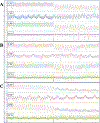Sudden Electrocardiogram Rhythm Changes after Return of Spontaneous Circulation in Porcine Models of Out-of-Hospital Cardiac Arrest: A Phenomenological Report
- PMID: 36193987
- PMCID: PMC10123171
- DOI: 10.1080/10903127.2022.2132333
Sudden Electrocardiogram Rhythm Changes after Return of Spontaneous Circulation in Porcine Models of Out-of-Hospital Cardiac Arrest: A Phenomenological Report
Abstract
Background: Observation of the electrocardiogram (ECG) immediately following return of spontaneous circulation (ROSC) in resuscitated swine has revealed the interesting phenomenon of sudden ECG rhythm changes (SERC) that occur in the absence of pharmacological, surgical, or other medical interventions.
Objective: We sought to identify, quantify, and characterize post-ROSC SERC in successfully resuscitated swine.
Methods: We reviewed all LabChart data from resuscitated approximately 4- to 6-month-old swine used for various experimental protocols from 2006 to 2019. We identified those that achieved sustained ROSC and analyzed their entire post-ROSC periods for evidence of SERC in the ECG, and arterial and venous pressure tracings. Presence or absence of SERC was confirmed independently by two reviewers (ACK, DDS). We measured the interval from ROSC to first SERC, analyzed the following metrics, and calculated the change from 60 sec pre-SERC (or from ROSC if less than 60 sec) to 60 sec post-SERC: heart rate, central arterial pressure (CAP), and central venous pressure (CVP).
Results: A total of 52 pigs achieved and sustained ROSC. Of these, we confirmed at least one SERC in 25 (48.1%). Two pigs (8%) each had two unique SERC events. Median interval from ROSC to first SERC was 3.8 min (inter-quartile range 1.0-6.9 min; range 16 sec to 67.5 min). We observed two distinct types of SERC: type 1) the post-SERC heart rate and arterial pressure increased (72% of cases); and type 2) the post-SERC heart rate and arterial pressure decreased (28% of cases). For type 1 cases, the mean (standard deviation [SD]) heart rate increased by 33.6 (45.7) beats per minute (bpm). The mean (SD) CAP increased by 20.6 (19.2) mmHg. For type 2 cases, the mean (SD) heart rate decreased by 39.7 (62.3) bpm. The mean (SD) CAP decreased by 21.9 (15.6) mmHg.
Conclusions: SERC occurred in nearly half of all cases with sustained ROSC and can occur multiple times per case. First SERC most often occurred within the first 4 minutes following ROSC. Heart rate, CAP, and CVP changed at the moment of SERC. We are proceeding to examine whether this phenomenon occurs in humans post-cardiac arrest and ROSC.
Conflict of interest statement
Disclosure: The authors have nothing to disclose in relation to this report.
Figures


References
-
- Lund-Kordahl I, Olasveengen TM, Lorem T, Samdal M, Wik L, Sunde K. “Improving outcome after out-of-hospital cardiac arrest by strengthening weak links of the local Chain of Survival; quality of advanced life support and post-resuscitation care.” Resuscitation. 2010; 81:422–426. - PubMed
-
- Wissenberg M, Lippert FK, Folke F, Weeke P, Hansen CM, Christensen EF, Jans H, Hansen PA, Lang-Jensen T, Olesen JP, Lindhardsen J, Fosbol EL, Nielsen SL, Gislason GH, Kober L, Torp-Pedersen C. “Association of national initiatives to improve cardiac arrest management with rates of bystander intervention and patient survival after out-of-hospital cardiac arrest.” JAMA. 2013; 310:1377–1384. - PubMed
Publication types
MeSH terms
Substances
Grants and funding
LinkOut - more resources
Full Text Sources
Medical
Research Materials
Miscellaneous
